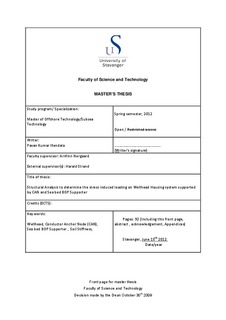| dc.contributor.author | Illendala, Pavan Kumar | |
| dc.date.accessioned | 2012-10-16T11:57:06Z | |
| dc.date.available | 2012-10-16T11:57:06Z | |
| dc.date.issued | 2012-06-14 | |
| dc.identifier.uri | http://hdl.handle.net/11250/182900 | |
| dc.description | Master's thesis in Offshore technology | no_NO |
| dc.description.abstract | The present work investigates the effect of the bending loads on the wellhead systems and predicts
the response of the conductor with the introduction of CAN™ (Conductor Anchor Node) and Seabed
BOP Supporter.
Performance of the wellhead and conductor system is dependent on field design parameters. These
parameters can include local environmental loading, drilling rig motions, marine riser stack-ups and
BOP (Blow-out Preventer) configuration and soil conditions. These loads may cause severe
damage to the wellhead system. In order to reduce the effect of these loads, the possibility of
incorporating other components such as the CAN™ and Seabed BOP Supporter can be
considered.
The present work aims at introducing the mentioned CAN™ and Seabed BOP Supporter in the
wellhead system and assessing their influence on the bending moment response of the conductor.
This has been analyzed considering different load cases outlined below.
Load Case 1: The analysis was carried out considering a conventional drilling mode with a 30”
wellhead system, drilling riser and a BOP system.
Load Case 2: The analysis was performed considering Wellhead system with BOP and drilling riser
supported in a CAN™ foundation developed by NeoDrill AS.
Load Case 3: The analysis also considers Seabed BOP Support in addition to the CAN™. The
Seabed BOP Supporter is located in between CAN™ and BOP. The purpose of a Sea bed BOP
supporter is to transfer pre-set part of BOP weight directly to CAN™ and to counteract riser induced
BOP moments on Wellhead.
3-D FE (Finite Element) model based on PIPE element was established for the mentioned three
load cases. The analyses have been performed by considering various factors that include internal
axial casing load, external load from BOP, drilling riser tension, foundation soil support stiffness,
and the cement level within the annulus of the conductor and surface casing. The shear loads that
occur when the well is configured for drilling operations are applied at the lower flex joint over a
range from -490kN to +490kN.
The results from the analysis are discussed against the two criteria established to assess the
structural integrity of the wellhead conductor. These criteria are: allowable bending capacity of the
conductor and limiting flex joint rotation angles. The results show that the introduction of CAN™ and Seabed BOP Supporter influences the
response for bending moment of Wellhead conductor considerably. The results further conclude
that the reduction in the bending moment of the conductor is in the order of 25% and 80% due to
introduction of CAN™ and Seabed BOP Supporter in the wellhead system, respectively. | no_NO |
| dc.language.iso | eng | no_NO |
| dc.publisher | University of Stavanger, Norway | no_NO |
| dc.relation.ispartofseries | Masteroppgave/UIS-TN-IKM/2012; | |
| dc.subject | conductor anchor node (CAN) | no_NO |
| dc.subject | seabed BOP supporter | no_NO |
| dc.subject | offshore teknologi | no_NO |
| dc.subject | undervannsteknologi | no_NO |
| dc.subject | wellhead | no_NO |
| dc.title | Structural analysis to determine the stress induced loading on Wellhead Housing system supported by CAN and sea bed BOP supporter | no_NO |
| dc.type | Master thesis | no_NO |
| dc.subject.nsi | VDP::Technology: 500::Marine technology: 580::Offshore technology: 581 | no_NO |
